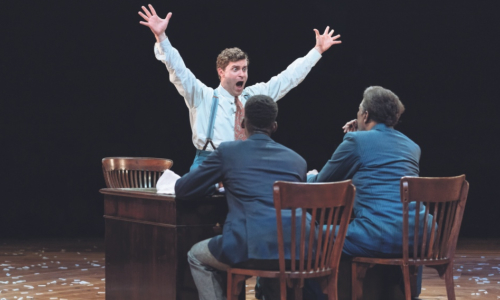Review: The American Clock

The American Clock is Arthur Miller’s attempt to chart the death of the old America and the traumatic birth of the new in the years following the Great Depression.
It has a loose, fidgety structure – it’s a series of vignettes, really – but the central dramatic arc follows the Baums, a well-to-do family who, like virtually everyone in the country, were wiped out by the crash of 1929.
You can see the motivation for reviving this unloved play for a 2019 audience – the lurching panic Miller describes when the rug was pulled from beneath a nation pumped up on over-inflated stocks feels depressing familiar in these post-Great Recession times. Lines like “How do you stop everything that’s big from swallowing everything that’s small?” could be from lifted a contemporary think-piece on Amazon, while the flourishing of far left and far right ideologies is once again playing out across the world.
But this is not one of Miller’s better plays, and this production does a splendid job of triple-underlining why, as well as tossing in a bunch of flaws of its own.
It leans heavily into vaudeville, with extravagant song and dance numbers, musical interludes, and surreal skits all intertwining to create a frankly bewildering tapestry. It’s rare to find a production of this size, at a theatre of this esteem, that feels so disjointed, so much like a work in progress, so fundamentally broken.
Even the most dramatic scenes, such as water pouring down a stock exchange board, literally wiping out everyone’s money, feel flat. A rotating stage filled with an ensemble of 20 jitterbugging actors is somehow lifeless, little more than 1920s-themed wallpaper.
Working out who’s who is virtually impossible, with the action jumping from time to time and place to place, and multiple characters dressed in identical uniforms. I’m pretty sure the actors playing the Baum family switched places a couple of times, but I can’t be sure. It might have been to demonstrate how, in the face of such adversity, everyone becomes essentially interchangeable, a faceless mass of misery, but then again it might not.
It’s not all terrible: I enjoyed a dance competition in which couples waltzed for thousands of hours in exchange for quarters, or the company exec who tapped out a staccato rhythm and spun in his chair as he related his rise up the corporate ladder. And there are some strong individual performances: Clarke Peters, best known as The Wire’s Lester Freamon, adds gravitas to the role of de facto narrator Arthur, and Ewan Wardrop lights up the theatre every time he tap dances as the President of General Motors. But they can’t work miracles.
An extra bank of seats rises from the back of the stage, making for a bumper audience, and by the end of the three hours there were an awful lot of wriggling bottoms and people surreptitiously checking their watches.
More than a decade on from the financial crash, we’ve seen works that brilliantly capture the psychology, greed and illegality that led us to where we are today: the superlative Lehman Trilogy at the National Theatre, the innovative theatrical board-game that was Lies at the Almeida. Arthur Miller’s play, for all its prescience, pales in comparison.

